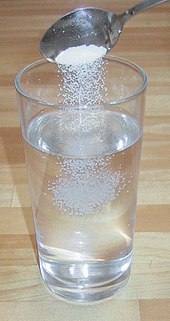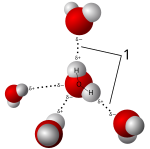Solution (chemistry)

In chemistry, a solution is a special type of homogeneous mixture composed of two or more substances. In such a mixture, a solute is a substance dissolved in another substance, known as a solvent. If the attractive forces between the solvent and solute particles are greater than the attractive forces holding the solute particles together, the solvent particles pull the solute particles apart and surround them. These surrounded solute particles then move away from the solid solute and out into the solution. The mixing process of a solution happens at a scale where the effects of chemical polarity are involved, resulting in interactions that are specific to solvation. The solution usually has the state of the solvent when the solvent is the larger fraction of the mixture, as is commonly the case. One important parameter of a solution is the concentration, which is a measure of the amount of solute in a given amount of solution or solvent. The term "aqueous solution" is used when one of the solvents is water.[1]
Characteristics
- A solution is a homogeneous mixtureof two or more substances.
- The particles of solute in a solution cannot be seen by the naked eye. By contrast, particles may be visible in a suspension.
- A solution does not cause beams of Tyndall scattering or Rayleigh scattering.
- A solution is stable, and solutes will not precipitate unless added in excess of the mixture's solubility, at which point the excess would remain in its solid phase. A solution containing more dissolved solutes than at equilibrium is referred to as supersaturated.
- The solutes and solvents in a solution cannot be separated by filtration (or mechanically).
- It is composed of only one phase.
This section needs expansion with: distinguish from other types of mixture (could be a separate section). You can help by adding to it. (August 2021) |
Types
This section is in prose. is available. (June 2014) |
Homogeneous means that the components of the mixture form a single phase. Heterogeneous means that the components of the mixture are of different phase. The properties of the mixture (such as concentration, temperature, and density) can be uniformly distributed through the volume but only in absence of diffusion phenomena or after their completion. Usually, the substance present in the greatest amount is considered the solvent. Solvents can be gases, liquids, or solids. One or more components present in the solution other than the solvent are called solutes. The solution has the same physical state as the solvent.
Gaseous mixtures
If the solvent is a
Liquid solutions
If the solvent is a liquid, then almost all gases, liquids, and solids can be dissolved. Here are some examples:
- Gas in liquid:
- Oxygen in water
- effervescenceof carbon dioxide that has come out of solution; the dissolved gas itself is not visible since it is dissolved on a molecular level.
- Liquid in liquid:
- The mixing of two or more substances of the same chemistry but different concentrations to form a constant. (Homogenization of solutions)
- Alcoholic beverages are basically solutions of ethanol in water.
- Solid in liquid:
- Sucrose (table sugar) in water
- Sodium chloride (NaCl) (table salt) or any other salt in water, which forms an electrolyte: When dissolving, salt dissociates into ions.
- aqueous solutions.
- Non-aqueous solutions are when the liquid solvent involved is not water.[1]
Counterexamples are provided by liquid mixtures that are not
are not considered solutions.Solid solutions
If the solvent is a solid, then gases, liquids, and solids can be dissolved.
- Gas in solids:
- Hydrogen dissolves rather well in metals, especially in palladium; this is studied as a means of hydrogen storage.
- Liquid in solid:
- Mercury in gold, forming an amalgam
- Water in solid salt or sugar, forming moist solids
- Hexane in paraffin wax
- Polymers containing plasticizers such as phthalate (liquid) in PVC (solid)
- Solid in solid:
- Steel, basically a solution of carbon atoms in a crystalline matrix of iron atoms[clarification needed]
- Alloys like bronze and many others
- Radium sulfate dissolved in barium sulfate: a true solid solution of Ra in BaSO4
Solubility
The ability of one compound to dissolve in another compound is called solubility.[clarification needed] When a liquid can completely dissolve in another liquid the two liquids are miscible. Two substances that can never mix to form a solution are said to be immiscible.
All solutions have a positive
Usually, the greater the temperature of the solvent, the more of a given solid solute it can dissolve. However, most gases and some compounds exhibit solubilities that decrease with increased temperature. Such behavior is a result of an
Properties
The physical properties of compounds such as
The properties of ideal solutions can be calculated by the linear combination of the properties of its components. If both solute and solvent exist in equal quantities (such as in a 50% ethanol, 50% water solution), the concepts of "solute" and "solvent" become less relevant, but the substance that is more often used as a solvent is normally designated as the solvent (in this example, water).
Liquid solution characteristics
In principle, all types of liquids can behave as solvents: liquid

Salts dissolve in polar solvents, forming positive and negative ions that are attracted to the negative and positive ends of the solvent molecule, respectively. If the solvent is water, hydration occurs when the charged solute ions become surrounded by water molecules. A standard example is aqueous saltwater. Such solutions are called electrolytes. Whenever salt dissolves in water ion association has to be taken into account.
Polar solutes dissolve in polar solvents, forming polar bonds or hydrogen bonds. As an example, all alcoholic beverages are aqueous solutions of ethanol. On the other hand, non-polar solutes dissolve better in non-polar solvents. Examples are hydrocarbons such as oil and grease that easily mix, while being incompatible with water.
An example of the immiscibility of oil and water is a leak of petroleum from a damaged tanker, that does not dissolve in the ocean water but rather floats on the surface.
Preparation from constituent ingredients
It is common practice in laboratories to make a solution directly from its constituent ingredients. There are three cases in practical calculation:
- Case 1: amount of solvent volume is given.
- Case 2: amount of solute mass is given.
- Case 3: amount of final solution volume is given.
In the following equations, A is solvent, B is solute, and C is concentration. Solute volume contribution is considered through the ideal solution model.
- Case 1: amount (mL) of solvent volume VA is given. Solute mass mB = C VA dA /(100-C/dB)
- Case 2: amount of solute mass mB is given. Solvent volume VA = mB (100/C-1/ dB )
- Case 3: amount (mL) of final solution volume Vt is given. Solute mass mB = C Vt /100; Solvent volume VA=(100/C-1/ dB) mB
- Case 2: solute mass is known, VA = mB 100/C
- Case 3: total solution volume is known, same equation as case 1. VA=Vt; mB = C VA /100
Example: Make 2 g/100mL of NaCl solution with 1 L
- mB = C VA = ( 2 / 100 ) g/mL × 1000 mL = 20 g
Chemists often make concentrated stock solutions that may then be diluted as needed for laboratory applications. Standard solutions are those where concentrations of solutes are accurately and precisely known.
See also
- Molar solution– Measure of concentration of a chemical
- Percentage solution (disambiguation)
- Solubility equilibrium – Thermodynamic equilibrium between a solid and a solution of the same compound
- Total dissolved solids – Measurement in environmental chemistry is a common term in a range of disciplines, and can have different meanings depending on the analytical method used. In water quality, it refers to the amount of residue remaining after the evaporation of water from a sample.
- Upper critical solution temperature – Critical temperature of miscibility in a mixture
- Lower critical solution temperature – Critical temperature below which components of a mixture are miscible for all compositions
- Coil–globule transition – Collapse of a macromolecule from an expanded coil state to a collapsed globule state
References
- ^ a b "Solutions". Washington University Chemistry Department. Washington University. Retrieved 13 April 2018.
External links
 Media related to Solutions at Wikimedia Commons
Media related to Solutions at Wikimedia Commons





